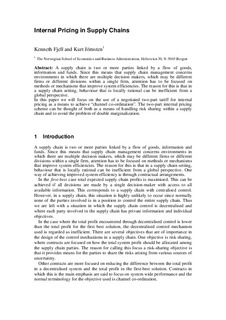| dc.contributor.author | Fjell, Kenneth | |
| dc.contributor.author | Jörnsten, Kurt | |
| dc.date.accessioned | 2006-07-13T18:06:24Z | |
| dc.date.available | 2006-07-13T18:06:24Z | |
| dc.date.issued | 2001 | |
| dc.identifier.issn | 1500-4066 | |
| dc.identifier.uri | http://hdl.handle.net/11250/164031 | |
| dc.description.abstract | A supply chain is two or more parties linked by a flow of goods, information and funds. Since this means that supply chain management concerns environments in which there are multiple decision makers, which may be different firms or different divisions within a single firm, attention has to be focused on methods or mechanisms that improve system efficiencies. The reason for this is that in a supply chain setting, behavior that is locally rational can be inefficient from a global perspective. In this paper we will focus on the use of a negotiated two-part tariff for internal pricing as a means to achieve "channel co-ordination". The two-part internal pricing scheme can be thought of both as a means of handling risk sharing within a supply chain and to avoid the problem of double marginalization. | en |
| dc.format.extent | 20126 bytes | |
| dc.format.mimetype | application/pdf | |
| dc.language.iso | eng | en |
| dc.publisher | Norwegian School of Economics and Business Administration. Department of Finance and Management Science | en |
| dc.relation.ispartofseries | Discussion paper | en |
| dc.relation.ispartofseries | 2001:14 | en |
| dc.title | Internal pricing in supply chains | en |
| dc.type | Working paper | en |
